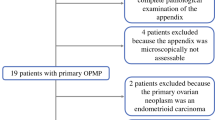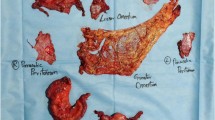Abstract
Background
Total parietal peritonectomy (TPP) removes areas of “normal-appearing” parietal peritoneum bearing microscopic residual disease and has the potential to improve survival of patients undergoing interval cytoreductive surgery (CRS) for advanced serous epithelial ovarian cancer. This report presents the morbidity outcomes for the first 50 patients enrolled in TORPEDO (CTRI/2018/12/016789), a prospective study.
Methods
All the patients underwent a TPP during interval CRS. A surgical protocol that includes a description of the boundaries for each of the five peritonectomies was followed. The common toxicology criteria for adverse events (CTCAE) classification was used to record 90-day morbidity and mortality.
Results
The median Peritoneal Cancer Index (PCI) for 50 patients was 15 (range, 5–37). A complete cytoreduction (CC-0 resection) was obtained in 80%, a CC-1 resection in 16%. A bowel resection was performed in 70% of the patients. Grade 3 or 4 complications were seen in 11 patients (22%), and one patient died within 90 days after surgery due to intraperitoneal hemorrhage. The most common complications were postoperative fluid collection requiring aspiration (n = 5), intraperitoneal hemorrhage (n = 2), abdominal wound dehiscence (n = 2), pseudo-obstruction (n = 1), urinary sepsis (n = 2), and ileostomy-related complications (n = 2). No bowel fistulas or anastomotic leaks occurred. Microscopic disease in ‘normal appearing’ peritoneum adjacent to tumor nodules was observed in 46% of the patients, and in regions given a lesion score of 0 in 34%. The parietal peritoneal regions (0–8) had a higher incidence of residual disease (p < 0.001) and occult disease (p < 0.001).
Conclusions
During interval CRS, TPP can be performed with acceptable morbidity and mortality. The pathologic findings further support this therapeutic rationale. Survival outcomes should determine the future role of such a procedure in routine clinical practice.

Similar content being viewed by others
References
Prat J, FIGO Committee on Gynecologic Oncology. Staging classification for cancer of the ovary, fallopian tube, and peritoneum. Int J Gynaecol Obstet. 2014;124:1–5.
Bhatt A, Glehen O. The role of cytoreductive surgery and hyperthermic intraperitoneal chemotherapy (HIPEC) in ovarian cancer: a review. Indian J Surg Oncol. 2016;7:188–97. https://doi.org/10.1007/s13193-016-0501-9.
Baratti D, Kusamura S, Cabras AD, Deraco M. Cytoreductive surgery with selective versus complete parietal peritonectomy followed by hyperthermic intraperitoneal chemotherapy in patients with diffuse malignant peritoneal mesothelioma: a controlled study. Ann Surg Oncol. 2012;19:1416–24.
Deraco M1, Sinukumar S2, Salcedo-Hernández RA3, Rajendra VJ4, Baratti D5, Guaglio M6, Nizri E7, Kusamura S8. Clinicopathological outcomes after total parietal peritonectomy, cytoreductive surgery and hyperthermic intraperitoneal chemotherapy in advanced serous papillary peritoneal carcinoma submitted to neoadjuvant systemic chemotherapy: largest single-institute experience. Eur J Surg Oncol. 2019;45:2103–8. https://doi.org/10.1016/j.ejso.2019.06.021. Epub 13 June 2019.
Pentheroudakis G, Pavlidis N. Serous papillary peritoneal carcinoma: unknown primary tumour, ovarian cancer counterpart or a distinct entity? A systematic review. Crit Rev Oncol Hematol. 2010;75:27e42.
Huang LW, Garrett AP, Schorge JO, Michael G, BellAD, Welch RW, et al. Distinct allelic loss patterns in papillary serous carcinoma of the peritoneum. Am J Clin Pathol. 2000;114:93e9.
Albanese AM1, Albanese EF, Miño JH, Gómez E, Gómez M, Zandomeni M, Merlo AB. Peritoneal surface area: measurements of 40 structures covered by peritoneum: correlation between total peritoneal surface area and the surface calculated by formulas. Surg Radiol Anat. 2009;31:369–77. https://doi.org/10.1007/s00276-008-0456-9. Epub 14 January 2009.
Yonemura Y, Kawamura T, Bandou E, Tsukiyama G, Endou Y, Miura M. The natural history of free cancer cells in the peritoneal cavity. In: Gonzalez-Moreno S (ed) Advances in Peritoneal Surface Oncology. Springer-Verlag, Berlin Heidelberg, Germany, 2007, pp 11–23.
Chi DS1, Bristow RE, Armstrong DK, Karlan BY. Is the easier way ever the better way? J Clin Oncol. 2011;29:4073–5. https://doi.org/10.1200/jco.2011.35.9935. Epub 19 September 2011.
Papademetriou K, Ardavanis A, Kountourakis P. Neoadjuvant therapy for locally advanced breast cancer: focus on chemotherapy and biological targeted treatments’ armamentarium. J Thoracic Dis. 2010;2:160–70. https://doi.org/10.3978/j.issn.2072-1439.2010.02.03.
Hynninen J, Lavonius M, Oksa S, et al. Is perioperative visual estimation of intraabdominal tumor spread reliable in ovarian cancer surgery after neoadjuvant chemotherapy? Gynecol Oncol. 2013;128:229–32, 2013.
Goswami G1, Kammar P2, Mangal R1, Shaikh S3, Patel MD3, Bhatt A3. Accuracy of CT scan in predicting the surgical PCI in patients undergoing cytoreductive surgery with/without HIPEC: a prospective single-institution study. Indian J Surg Oncol. 2019;10:296–302. https://doi.org/10.1007/s13193-019-00914-9. Epub 28 Mar 2019.
Lim MC1, Song YJ, Seo SS, Yoo CW, Kang S, Park SY. Residual cancer stem cells after interval cytoreductive surgery following neoadjuvant chemotherapy could result in poor treatment outcomes for ovarian cancer. Onkologie. 2010;33:324–30. https://doi.org/10.1159/000313823. Epub 2010 May 14.
Sinukumar S, Rajan F, Mehta S, Damodaran D, Zaveri S, Kammar P, et al. A comparison of outcomes following total and selective peritonectomy performed at the time of interval cytoreductive surgery for advanced serous epithelial ovarian, fallopian tube, and primary peritoneal cancer: a study by INDEPSO. Eur J Surg Oncol. 2019. pii: S0748-7983(19)30304–X. https://doi.org/10.1016/j.ejso.2019.02.031.
van Driel WJ, Koole SN, Sikorska K, Schagen van Leeuwen JH, Schreuder HWR, Hermans RHM, et al. Hyperthermic intraperitoneal chemotherapy in ovarian cancer. N Engl J Med. 2018;378:230–40.
NCCN Guidelines for ovarian cancer. Retrieved 4 March 2020 at https://www.nccn.org/patients/guidelines/content/PDF/ovarian-patient.pdf.
United States Department of Public Health and Human Services, NIH, NCI: Common Toxicity Criteria for Adverse Events (CTCAE). National Cancer Institute, June 2010. https://evs.nci.nih.gov/ftp1/CTCAE_Vers._4.03_2010-06-14;_QuickReference_5x7.pdf.
Jacquet P, Sugarbaker PH. Clinical research methodologies in diagnosis and staging of patients with peritoneal carcinomatosis. Cancer Treat Res. 1996;82:359–74.
Bhatt A, Yonemura Y, Benzerdjeb N, et al. Pathological assessment of cytoreductive surgery specimens and its unexplored prognostic potential: a prospective multi-centric study. Eur J Surg Oncol. 2019;45:2398–404.
McCluggage WG, Judge MJ, Clarke BA, Davidson B, Gilks CB, Hollema H, et al. International collaboration on cancer reporting: data set for reporting of ovary, fallopian tube, and primary peritoneal carcinoma: recommendations from the International Collaboration on Cancer Reporting (ICCR). Mod Pathol. 2015;28:1101–22. https://doi.org/10.1038/modpathol.2015.77.
Bhatt A, Yonemura Y, Mehta S, Benzerdjeb N, Kammar P, Parikh L, et al. The Pathologic Peritoneal Cancer Index (PCI) strongly differs from the surgical PCI in peritoneal metastases arising from various primary tumors. Ann Surg Oncol. 2020;27:2985–96. https://doi.org/10.1245/s10434-020-08234-x.
Böhm S, Faruqi A, Said I, Lockley M, Brockbank E, Jeyarajah A, et al. Chemotherapy response score: development and validation of a system to quantify histopathologic response to neoadjuvant chemotherapy in tubo-ovarian high-grade serous carcinoma. J Clin Oncol. 2015;33:2457–63. https://doi.org/10.1200/JCO.2014.60.5212.
Di Giorgio A, De Iaco P, De Simone M, et al. Cytoreduction (peritonectomy procedures) combined with hyperthermic intraperitoneal chemotherapy (HIPEC) in advanced ovarian cancer: retrospective Italian multicenter observational study of 511 cases. Ann Surg Oncol. 2017;24:914–22.
Bakrin N, Bereder JM, Decullier E, et al. Peritoneal carcinomatosis treated with cytoreductive surgery and hyperthermic intraperitoneal chemotherapy (HIPEC) for advanced ovarian carcinoma: a French multicentre retrospective cohort study of566 patients. Eur J Surg Oncol. 2013;39:1435–43. https://doi.org/10.1016/j.ejso.2013.09.030.
Harter P, Sehouli J, Lorusso D, et al. A randomized trial of lymphadenectomy in patients with advanced ovarian neoplasms. N Engl J Med. 2019;380:822–32.
Alyami M, Kim BJ, Villeneuve L, et al. Ninety-day postoperative morbidity and mortality using the National Cancer Institute’s common terminology criteria for adverse events better describe postoperative outcome after cytoreductive surgery and hyperthermic intraperitoneal chemotherapy. Int J Hyperthermia. 2018;34:532–7.
Sinukumar S, Mehta S, Damodaran D, et al. Failure-to-rescue following cytoreductive surgery with or without HIPEC is determined by the type of complication: a retrospective study by INDEPSO. Indian J Surg Oncol. 2019;10(Suppl 1):71–9. https://doi.org/10.1007/s13193-019-00877-x.
Bhatt A, Sinukumar S, Mehta S, Damodaran D, Zaveri S, Kammar P, et al. Patterns of pathological response to neoadjuvant chemotherapy and its clinical implications in patients undergoing interval cytoreductive surgery for advanced serous epithelial ovarian cancer: a study by the Indian Network for Development of Peritoneal Surface Oncology (INDEPSO). Eur J Surg Oncol. 2019;45:666–71. https://doi.org/10.1016/j.ejso.2019.01.009. Epub 9 January 2019.
Sugarbaker PH1. Avoiding diverting ileostomy in patients requiring complete pelvic peritonectomy. Ann Surg Oncol. 2016;23:1481–5. https://doi.org/10.1245/s10434-015-4961-x. Epub 5 November 2015.
Bhatt A, Sinukumar S, Rajan F, Damodaran D, Ray M, Zaveri S, et al. Impact of radicality versus timing of surgery in patients with advanced ovarian cancer (stage III C) undergoing CRS and HIPEC: a retrospective study by INDEPSO. Indian J Surg Oncol. 2019;10(Suppl 1):57. https://doi.org/10.1007/s13193-019-00875-z.
Harlaar NJ1, Koller M1, de Jongh SJ2, van Leeuwen BL1, Hemmer PH1, Kruijff S1, et al.. Molecular fluorescence-guided surgery of peritoneal carcinomatosis of colorectal origin: a single-centre feasibility study. Lancet Gastroenterol Hepatol. 2016;1:283–90. https://doi.org/10.1016/s2468-1253(16)30082-6. Epub 2016 Sep 17.
Sugarbaker PH. Preoperative assessment of cancer patients with peritoneal metastases for complete cytoreduction. Indian J Surg Oncol. 2016;7:295–302.
Author information
Authors and Affiliations
Corresponding author
Ethics declarations
Disclosure
There are no conflicts of interest.
Additional information
Publisher's Note
Springer Nature remains neutral with regard to jurisdictional claims in published maps and institutional affiliations.
Electronic supplementary material
Below is the link to the electronic supplementary material.
Rights and permissions
About this article
Cite this article
Bhatt, A., Kammar, P., Sinukumar, S. et al. Total Parietal Peritonectomy Can Be Performed with Acceptable Morbidity for Patients with Advanced Ovarian Cancer After Neoadjuvant Chemotherapy: Results From a Prospective Multi-centric Study. Ann Surg Oncol 28, 1118–1129 (2021). https://doi.org/10.1245/s10434-020-08918-4
Received:
Accepted:
Published:
Issue Date:
DOI: https://doi.org/10.1245/s10434-020-08918-4




